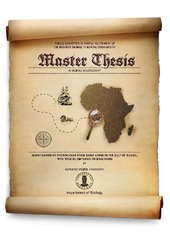Investigation of crustaceans from shelf areas in the Gulf of Guinea, with special emphasis on Brachyura
Abstract
Crustacean abundance on continental shelves off Nigeria, Cameroon and Gabon in the Gulf of Guinea was investigated in this study. Quantitative data was sampled with a 0.1 m² Van Veen grab during a survey with RV Dr. Fridtjof Nansen in 2005. The Brachyuran fauna was identified based on the grab samples from 2005 as well as from demersal trawl samples collected in the Gulf of Guinea during 2005, 2006 and 2007. The findings of the current investigation were compared with results of previous studies in West Africa. Hydrographical data of depth, temperature, oxygen and salinity were obtained and their effect on species distribution and abundance was tested using ordination analysis. Molecular sequencing of the cytochrome c oxidase subunit 1 (COI) gene was attempted for ten brachyuran species. The most common crustacean order encountered in the sediment samples off Nigeria, Cameroon and Gabon was Amphipoda. Gabon had the highest abundance of crustaceans, whereas the benthic fauna in Cameroon was composed of the highest percentage of brachyurans (7.99%). A total of 291 brachyuran specimens were collected at the investigated trawl and grab stations. It was possible to identify 45 species, of which three (Ebalia cranchii, Ilia nucleus and Herbstia condyliata) were recorded in the southern part of the Gulf of Guinea for the first time. Including brachyurans recorded in previous investigations, a total of 86 species of Brachyura have been recorded from Nigeria, Cameroon and Gabon. New distribution ranges were identified for several brachyuran species. Temperature emerged as a significant (P<0.05) parameter in affecting distribution ranges of the brachyuran grab fauna, which seemed to prefer habitats of medium depths and relatively high salinity levels. No clear distribution pattern in relation to environmental variables was detected for the brachyuran trawl fauna. A COI sequence was obtained for three of the ten species subjected to molecular sequencing. The results of this study can be used for environmental monitoring and resource management.
Publisher
The University of BergenCopyright
The authorCopyright the author. All rights reserved
